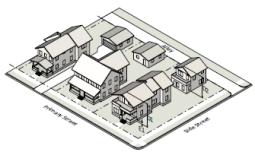On Monday, the Raleigh City Council began its weekly review of the Unified Development Ordinance.
What is the Unified Development Ordinance? We’re glad you asked. The Unified Development Ordinance, UDO for short, will be Raleigh’s new zoning code.
A few years ago, the Council adopted the 2030 Comprehensive Plan, which outlines the vision for Raleigh’s development and economic future. But, the Comp Plan is just a vision without some kind of text to make it happen.
The UDO is that text. It codifies the Comp Plan.
[media-credit name=”City of Raleigh” align=”alignleft” width=”255″] [/media-credit]The UDO will also make Raleigh’s zoning code more understandable, more clear and more organized than the current zoning code, at least that’s what city planners hope.
[/media-credit]The UDO will also make Raleigh’s zoning code more understandable, more clear and more organized than the current zoning code, at least that’s what city planners hope.
During the past two and a half years, Raleigh’s planning staff has made countless presentations to residents and elected officials. Most recently, the Raleigh Planning Commission reviewed the 12-chapter, 300-plus-page document over the course of 30 meetings. The commission addressed all the input made during the public comment period earlier this year.
The commission made 200 changes and recommendations for the City Council and officially passed the torch earlier this month.
At the first Monday workshop meeting, councilors discussed how they would tackle their own review of the massive text.
It will start with weekly meetings held on Mondays at 4 p.m. Staff will present the code chapter-by-chapter, reviewing the Planning Commission’s recommendations and answering councilors’ questions.
At the request of the council, planning staff will prepare 12 case studies that will show how the UDO will affect development. Using current site plans, staff will be able to show how that development would change if the UDO was in place today.
Councilor Thomas Crowder said that he would like to see what the intent of the code is and then what developers could legally get away with.
The Planning Commission initially had 105 days to review the UDO. It asked for two 45-day time extensions. City Council members, however, can take as long as they want.
But, even if the City Council adopted the UDO tomorrow, the process isn’t done yet.
Like the Comp Plan, the UDO needs a map. The map that will accompany the code will undergo its own public review process.
It is likely that it will be another two years before the City and the planning department will be able to celebrate the completion of the new code.
